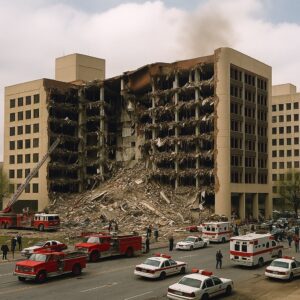On April 19, 1995, the United States was rocked by one of the deadliest acts of domestic terrorism in its history. A massive explosion ripped through the Alfred P. Murrah Federal Building in downtown Oklahoma City, killing 168 people, including 19 children, and injuring hundreds more. The attack, carried out by Timothy McVeigh and Terry Nichols, was a calculated act of terror fueled by anti-government extremism. In a matter of seconds, lives were lost, families were shattered, and the nation was forced to confront a new and horrifying reality—one where the threat didn’t come from foreign enemies but from within its own borders.
The attack was meticulously planned. McVeigh, a former U.S. Army soldier, and Nichols, his co-conspirator, built a bomb using ammonium nitrate fertilizer, diesel fuel, and other readily available materials. They packed it into a Ryder truck and parked it in front of the federal building, timing the detonation for just after 9:00 a.m. The resulting explosion was catastrophic, collapsing much of the nine-story structure and leaving a scene of utter devastation. First responders worked tirelessly to rescue survivors from the rubble, but for many, it was too late. The blast claimed innocent lives—government workers, military personnel, and even young children in the building’s daycare center.
The motive behind the bombing was deeply rooted in McVeigh’s anger over government actions, particularly the deadly sieges at Ruby Ridge in 1992 and Waco in 1993. He viewed these events as examples of government overreach and sought revenge. In the aftermath of the attack, investigators quickly identified McVeigh as a suspect after he was arrested for a traffic violation just 90 minutes after the bombing. Nichols was later apprehended, and both men were held accountable for their crimes—McVeigh was executed in 2001, while Nichols received life in prison.
The Oklahoma City bombing sent shockwaves across the nation, prompting changes in security measures and counterterrorism efforts. It was a wake-up call about the dangers of domestic extremism and the devastating consequences of radical ideologies. Each year, on April 19, survivors, families of the victims, and the city of Oklahoma City come together to remember those lost. The Oklahoma City National Memorial stands as a powerful tribute, ensuring that their stories are never forgotten.
In a time when threats to national security continue to evolve, the lessons of the Oklahoma City bombing remain critical. It serves as a reminder of the destructive power of hate and the importance of vigilance against extremist threats. More importantly, it highlights the resilience of a nation that, even in the face of tragedy, refuses to be broken.

